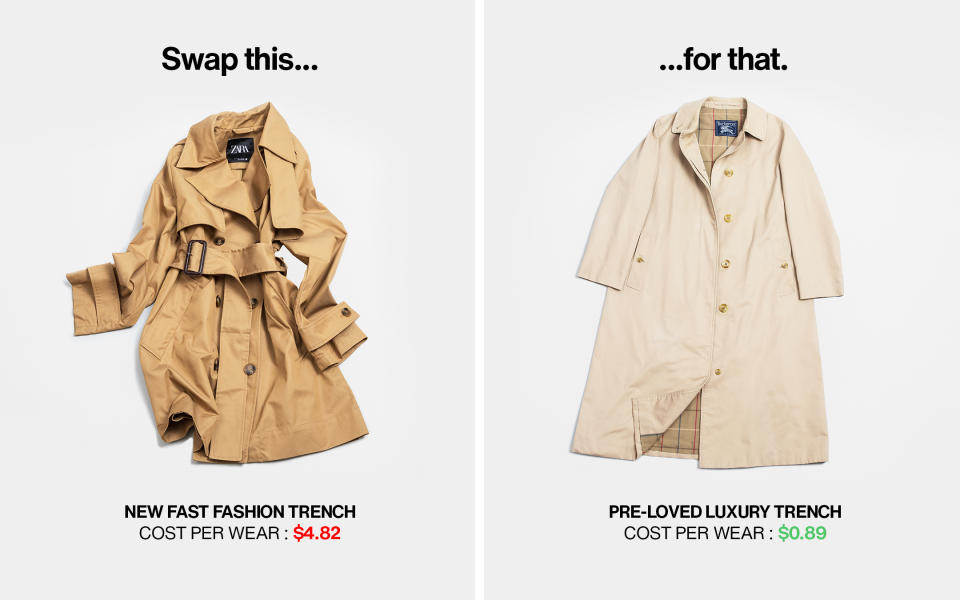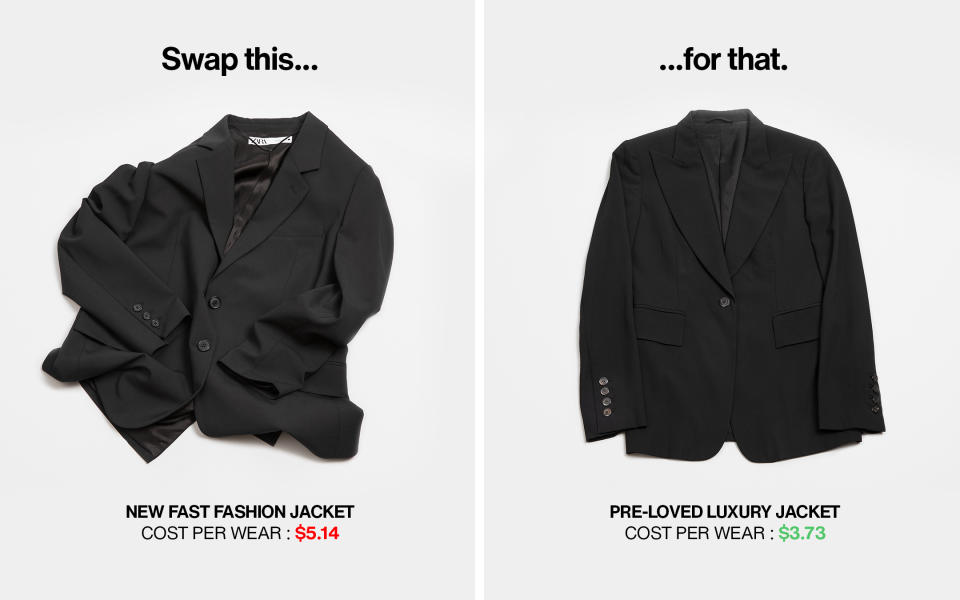New Report Shows Why Fast Fashion Is Worse for Your Wallet, on Top of the Environment

The world can’t afford fast fashion.
That’s the conclusion of new research from Vestiaire Collective, the leading global platform for pre-owned luxury fashion.
More from WWD
The report claims that beyond fast fashion’s devastating climate consequences, it’s a false notion that fast fashion is more affordable. As price barriers remain a significant consideration for consumers, Vestiaire has introduced a new approach to understanding the true value of fashion: the cost-per-wear metric.
The cost-per-wear metric sets out to show the true cost of an item based on its frequency of use, total lifespan and its resale value. While fast-fashion items might initially appear more financially attractive, the report contends that pre-owned curated fashion items are a more financially sound investment in the long term.
“In today’s climate of inflation, it is obvious: Neither people nor the planet can afford fast fashion. We want to educate consumers about the benefits of circularity, while sounding the alarm on fast fashion’s devastating impact. This report is a wake-up call to combat overconsumption and overspending, fueled by tempting low initial prices,” said Fanny Moizant, president and cofounder of Vestiaire Collective, which launched in Paris in 2009 and is a certified B Corp.
Vestiaire’s March 2024 study, done in collaboration with Vaayu, dives into consumer behavior, analyzing responses from 13,400 participants, alongside data from 250,000 transactions and insights from 28 qualitative interviews across key global markets. Through this study, Vestiaire aims to shift consumers’ perception of an item’s price, encouraging them to invest in financially, as well as environmentally, sustainable pieces. The report encourages fashion customers to take better care of their items due to their resale value and to invest in long-lasting, quality items.
According to Moizant, the secondhand industry is growing “super fast” and is a $200 billion industry that’s growing at a 15 to 20 percent rate.
Discussing what prompted this research, Moizant said, “This industry has been dramatically shifting. Fifteen years ago what we saw was tremendous waste created by something pretty new, which was overconsumption. We were seeing our peers consuming more and more and more…overconsumption was going through the roof and the number of times people were wearing their clothes were going down.”
She said that was the inception of Vestiaire. “At the time we were not even talking about sustainability, but we saw tremendous waste,” she said. She said they believed in durability, longevity and craftsmanship and what fashion should stand for.
She said Vestiaire undertook the study “for people to understand the true cost of fashion and the true bad cost of fast fashion.”
“There are hidden costs behind fast fashion beyond the shiny price tags you see in the stores,” continued Moizant. Three years ago, Vestiaire, which focuses on designer, premium and high-end brands, decided to take a stand against fast fashion and banned fast-fashion brands such as Asos, Shein, Burton, Fashion Nova, Pretty Little Thing, Missguided, Topman, TopShop, Zara and Gap from its site, as reported. It launched the fast-fashion ban campaign in November 2022 (banning 33 brands), had another wave last November (banning 30 brands) and has another one coming this fall.
Asked if she feels she has to beat down fast fashion to build up Vestiaire, she said: “For us, it’s the model that introduced overconsumption.”
Is she looking to get rid of fast fashion?
“I would love to honestly. I would love for those companies not to exist anymore. And for consumers to have more consciousness,” Moizant said. She said 40 percent of the orders on Vestiaire are below 100 euros. And these are brands that are not fast fashion. The average basket is around 350 euros.
The circularity report, titled “Exposing the True Cost of Fast Fashion,” discloses businesses’ environmental and social impact. It points out that 60 percent of fast-fashion items end up in landfills within a year of purchase. And 92 million tons of textiles are discarded every single year. “It’s an environmental and social disaster,” she said.
The report claims that high demand for pre-owned luxury shows no signs of slowing down, with Vestiaire Collective seeing 25 percent revenue growth in 2023, versus a 4 percent increase in the luxury industry. It also found that one in three buyers use Vestiaire Collective to source unique, hard-to-find items, with almost a quarter of a million searches for vintage in 2023, up 40 percent from the year earlier.
According to Vestiaire, fighting fast fashion is their number-one priority. In 2023, Vestiaire worked with a team of industry experts to define fast fashion for the first time with a set of five key criteria (very low prices, strong promotional intensity, rapid collection renewal rate, extremely wide range of products and record-setting speed to market). “When you have an enemy, you should be able to define them,” said Moizant.
The report noted after the ban of fast fashion, consumers didn’t quit their platform. Instead they changed their habits and moved to more premium brands. The research found that 92 percent of impacted buyers stayed with Vestiaire, and 88 percent of impacted sellers stayed with Vestiaire.
The report said fast fashion isn’t a niche corner of the market. Seven out of 10 items of clothing sold in France come from fast-fashion brands, “making it the dominant mode of consumption.” Vestiaire believes in buying higher-quality, pre-loved pieces that use better fabrics in more flattering cuts. “And while they might not be quite as mind-blowingly cheap, they’re more cost-effective in the long run, with a longer lifespan and a lower cost per wear,” according to the report.
The study also claims that shopping on Vestiaire is 35 percent cheaper in the long term than buying brand-new fast-fashion products.

Among the key claims in the report comparing Vestiaire to fast fashion:
When looking at comparable price ranges, pre-loved curated fashion coats are said to be worn four times more on average versus new fast-fashion coats (worn 28 times). The result in a cost per wear of $1.72 versus $4.82 for new fast-fashion coats.
Pre-loved curated fashion dresses are said to be worn eight times more on average versus new fast-fashion dresses (worn nine times). This result is a cost per wear of $1.56 versus $5.66 for new fast-fashion dresses.
Pre-loved designer bags have a minus 72 percent cost per wear as the resale value is more significant, resulting in a $2.56 cost per wear versus $9.05 for new fast-fashion items.
Across all categories and all price points, pre-owned curated fashion pieces offer about 33 percent lower cost per wear versus fast-fashion items, which are worn more than two times less on average.
Pre-loved curated fashion consumers hold on to their items 31 percent longer than average, with the higher gap in the shoe categories (+48 percent) versus average.
Regardless of the circumstances, the cost per wear is consistently lower when buying pre-owned items. According to the study, this is particularly true for seasonal and occasional items like coats and dresses.
“Affordable fast fashion is a false economy. Buying cheap fast fashion is deceptive as in the end you end up replacing items again and again. We champion circularity as it not only benefits consumers’ wallets, but also protects our planet. Pre-loved luxury items are more cost-effective over time with a longer lifespan. Our mantra, ‘Think First, Buy Second’ makes more sense than ever,” said Dounia Wone, chief impact officer of Vestiaire Collective.
Asked what Moizant hopes consumers will get out of the report, she said, “Fast fashion is no longer an option for them. They need to think about the planet, and think about their own wallet. We hope by this study they will be way more sensitive to their own wallets and will think wisely and more cautiously when they buy their next item,” she said.

To mark the report’s launch, Vestiaire has unveiled the next installment of its “Think First, Buy Second” campaign, which features a series of videos, testimonials and memes, appearing on social media channels starting Monday. Five months after the initial launch — which went viral on Instagram — this campaign will show the cost-per-wear approach and challenge perceptions to shatter the illusion of affordable fast fashion , encouraging conscious consumption to protect both personal finances and the environment.
Best of WWD

